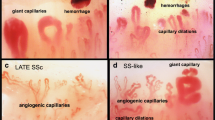Abstract
The objective of this study is to evaluate nailfold videocapillaroscopy changes in scleroderma patients treated regularly on cyclic basis with iloprost and to find associations with clinical, serologic, and pharmacological variables. Forty-nine patients affected by systemic sclerosis (44 women and five men, mean age 52.4 years, mean disease duration 8.0 years, 31 patients with limited cutaneous subset and 18 with diffuse cutaneous form of the disease) underwent two nailfold videocapillaroscopies at a distance of 3 years from each other; the examinations were performed by an operator blinded to clinical features and to drug treatment. Six patients showed an amelioration of nailfold videocapillaroscopic abnormalities who changed from active to early pattern; five of these cases (83.3%) had been given cyclophosphamide therapy and the remaining case methotrexate plus azathioprine. Cyclophosphamide administration was significantly associated with amelioration of nailfold videocapillaroscopic pattern (p < 0.001). None of the patients who received cyclophosphamide demonstrated worsening of the microvascular lesions; the progression of nailfold videocapillaroscopic pattern was inversely correlated to cyclophosphamide treatment (p = 0.02). In our study, cyclophosphamide treatment demonstrated to be effective for scleroderma microvascular damage as directly observed by nailfold videocapillaroscopy.

Similar content being viewed by others
References
Anderson ME, Allen PD, Moore T, Hillier V, Taylor CJ, Herrick AL (2005) Computerized nailfold videocapillaroscopy—a new tool for assessment of Raynaud’s phenomenon. J Rheumatol 32:841–848
Cutolo M, Pizzorni C, Sulli A (2005) Capillaroscopy. Best Pract Res Clin Rheumatol 19:437–452
Cutolo M, Grassi W, Matucci Cerinic M (2003) Raynaud’s phenomenon and the role of capillaroscopy. Arthritis Rheum 48:3023–3030
Cutolo M, Sulli A, Pizzorni C, Accardo S (2000) Nailfold videocapillaroscopy assessment of microvascular damage in systemic sclerosis. J Rheumatol 27:155–160
Cutolo M, Pizzorni C, Tuccio M et al (2004) Nailfold videocapillaroscopic patterns and serum autoantibodies in systemic sclerosis. Rheumatology 43:719–726
Caramaschi P, Canestrini S, Martinelli N et al (2007) In scleroderma patients nailfold videocapillaroscopic patterns are associated with disease subset and disease severity. Rheumatology 46:1566–1569
Subcommittee for scleroderma criteria of the American Rheumatism Association diagnostic and therapeutic criteria committee (1980) Preliminary criteria for the classification of systemic sclerosis (scleroderma). Arthritis Rheum 23:581–590
LeRoy EC, Black CM, Fleischmajer R et al (1988) Scleroderma (systemic sclerosis): classification, subsets and pathogenesis. J Rheumatol 15:202–205
Akesson A, Fiori G, Krieg T, van den Hoogen FHJ, Seibold JR (2002) Assessment of skin, joint, tendon and muscle involvement. Clin Exp Rheumatol 21(suppl 29):S5–8
Valentini G, Della Rossa A, Bombardieri S et al (2001) European multicentre study to define disease activity for systemic sclerosis. Identification of disease activity variables and development of preliminary activity indexes. Ann Rheum Dis 60:592–598
Filaci G, Cutolo M, Scudelletti M et al (1999) Cyclosporin A and iloprost treatment of systemic sclerosis: clinical results and interleukin-6 serum changes after 12 months of therapy. Rheumatology 38:992–996
Miniati I, Guiducci S, Conforti ML et al (2008) Autologous stem cell transplantation improves microcirculation in systemic sclerosis. Ann Rheum Dis May 26 (in press)
Sulli A, Secchi ME, Pizzorni C, Cutolo M (2008) Scoring the nailfold microvascular changes during the capillaroscopic analysis in systemic sclerosis patients. Ann Rheum Dis 67:885–887
Tashkin DP, Elashoff R, Clements PJ et al (2006) Cyclophosphamide versus placebo in scleroderma lung disease. NEJM 354:655–666
Tashkin DP, Elashoff R, Clements PJ et al (2007) Effects of 1-year treatment with cyclophosphamide on outcomes at 2 years in scleroderma lung disease. Am J Respir Crit Care Med 176:1026–1034
Prescott RJ, Freemont AJ, Jones CJ, Hoyland J, Fielding P (1992) Sequential dermal microvascular and perivascular changes in the development of scleroderma. J Pathol 166:255–263
Sakkas LI, Chikanza IC, Platsoucas CD (2006) Mechanisms of disease: the role of immune cells in the pathogenesis of systemic sclerosis. Nat Clin Pract Rheumatol 2:679–685
Hasegawa M, Fujimoto M, Kikuchi K, Takehara K (1997) Elevated serum levels of interleukin 4 (IL-4), IL-10, and IL-13 in patients with systemic sclerosis. J Rheumatol 24:328–332
Hénault J, Tremblay M, Clément I, Raymond Y, Senécal Y (2004) DNA binding of anti-DNA topoisomerase I autoantibodies to the cell surface of fibroblasts in patients with systemic sclerosis. Arthritis Rheum 50:3265–3274
Hénault J, Robtaille G, Senécal Y (2006) DNA topoisomerase I binding to fibroblasts induces monocyte adhesion and activation in the presence of anti-topoisomerase I antibodies from systemic sclerosis patients. Arthritis Rheum 54:963–973
Hasegawa M, Fujimoto M, Takehara K, Sato S (2005) Pathogenesis of systemic sclerosis: altered B cell function is the key linking systemic autoimmunity and tissue fibrosis. J Dermatol Sci 39:1–7
Sato S, Fujimoto M, Hasegawa M, Takehara K, Tedder TF (2004) Altered B lymphocyte function induces systemic autoimmunity in systemic sclerosis. Mol Immunol 41:1123–1133
Disclosures
None.
Author information
Authors and Affiliations
Corresponding author
Rights and permissions
About this article
Cite this article
Caramaschi, P., Volpe, A., Pieropan, S. et al. Cyclophosphamide treatment improves microvessel damage in systemic sclerosis. Clin Rheumatol 28, 391–395 (2009). https://doi.org/10.1007/s10067-008-1058-y
Received:
Revised:
Accepted:
Published:
Issue Date:
DOI: https://doi.org/10.1007/s10067-008-1058-y




